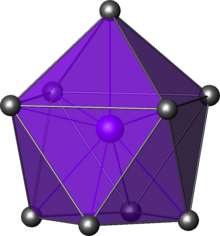|
Capped square antiprismatic molecular geometry
In chemistry, the capped square antiprismatic molecular geometry describes the shape of compounds where nine atoms, groups of atoms, or ligands are arranged around a central atom, defining the vertices of a gyroelongated square pyramid. The symmetry group of the resulting object is C4v The gyroelongated square pyramid is a square pyramid with a square antiprism connected to the square base. In this respect, it can be seen as a "capped" square antiprism (a square antiprism with a pyramid erected on one of the square faces). It is very similar to the tricapped trigonal prismatic molecular geometry, and there is some dispute over the specific geometry exhibited by certain molecules. Examples:
Bicapped square antiprismatic molecular geometrySquare antiprisms can be capped on both square faces, giving bicapped square antiprismatic molecular geometry. The bicapped square antiprismatic atoms surrounding a central atom define the vertices of a gyroelongated square bipyramid.[2] The symmetry group of this object is D4d.[3] Examples:
References
|
||||||||
